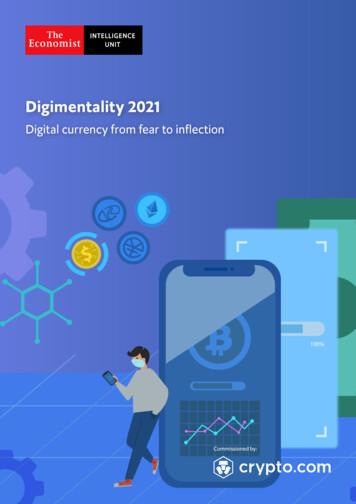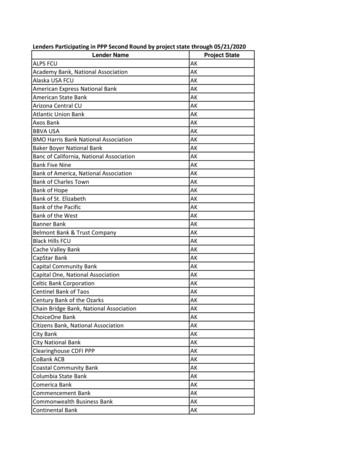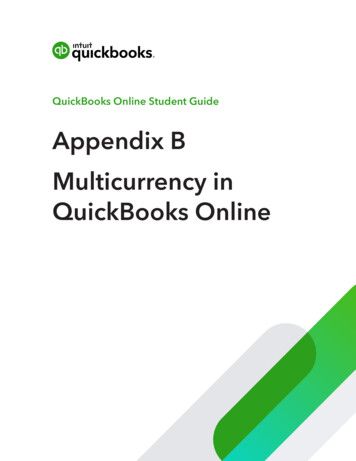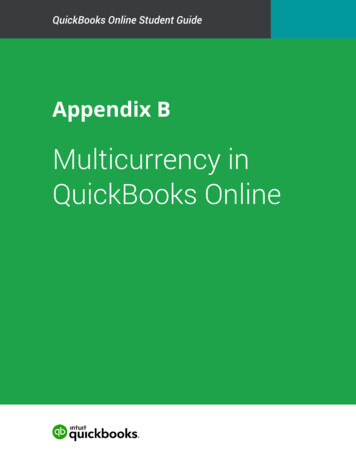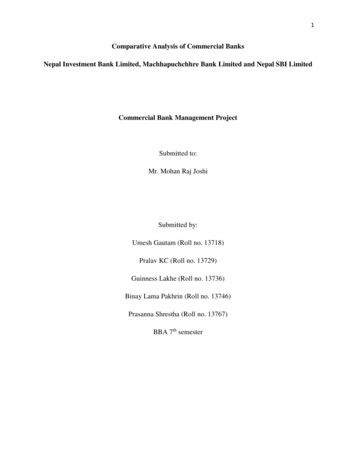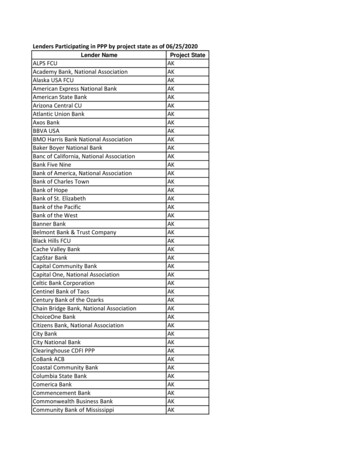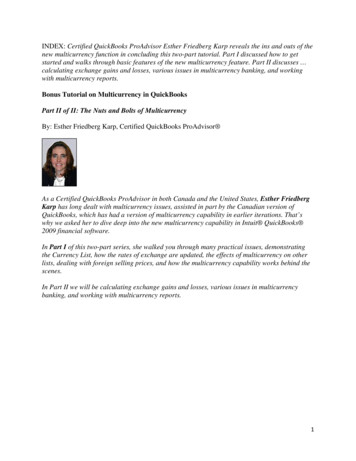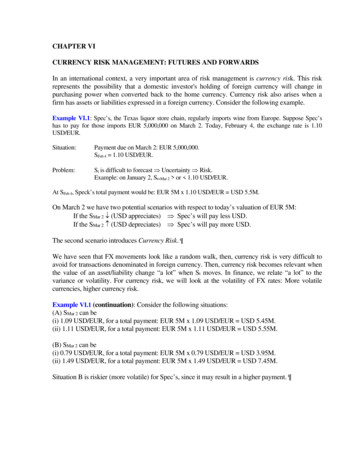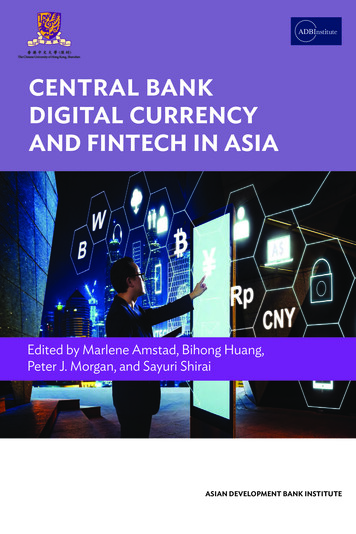
Transcription
CENTRAL BANKDIGITAL CURRENCYAND FINTECH IN ASIAEdited by Marlene Amstad, Bihong Huang,Peter J. Morgan, and Sayuri ShiraiASIAN DEVELOPMENT BANK INSTITUTE
CENTRAL BANKDIGITAL CURRENCYAND FINTECH IN ASIAEdited by Marlene Amstad, Bihong Huang,Peter J. Morgan, and Sayuri ShiraiASIAN DEVELOPMENT BANK INSTITUTE
2019 Asian Development Bank InstituteAll rights reserved. First printed in 2019.ISBN 978-4-89974-213-5 (Print)ISBN 978-4-89974-214-2 (PDF)The views in this publication do not necessarily reflect the views and policies of theAsian Development Bank Institute (ADBI), its Advisory Council, ADB’s Board orGovernors, or the governments of ADB members.ADBI does not guarantee the accuracy of the data included in this publicationand accepts no responsibility for any consequence of their use. ADBI usesproper ADB member names and abbreviations throughout and any variation orinaccuracy, including in citations and references, should be read as referring to thecorrect name.By making any designation of or reference to a particular territory or geographicarea, or by using the term “recognize,” “country,” or other geographical names inthis publication, ADBI does not intend to make any judgments as to the legal orother status of any territory or area.Users are restricted from reselling, redistributing, or creating derivative workswithout the express, written consent of ADBI.ADB recognizes “China” as the People’s Republic of China.Note: In this publication, “ ” refers to US dollars.Asian Development Bank InstituteKasumigaseki Building 8F3-2-5, Kasumigaseki, Chiyoda-kuTokyo 100-6008, Japanwww.adbi.org
ContentsTables, Figures, and Boxes viiForeword xiList of Contributors 1Introduction and Overview Introduction 1Fintech and Financial Inclusion 1The Challenges for Central Banks and Regulators 2Chapter Summaries 3PART 1Digital Currency and Fintech Principles and Foundations Money and Central Bank Digital Currency 911by Sayuri Shirai2.12.22.32.42.531by Marlene Amstad, Bihong Huang, Peter J. Morgan, and Sayuri Shirai1.11.21.31.42xiiiIntroduction 11Central Bank Money Performance 13Private Sector Money Performance 19 Central Bank Digital Currency Proposals and Prospects 27 Conclusions 39Regulating Fintech: Objectives, Principles, and Practices 42by Marlene Amstad3.13.23.33.43.5Introduction 42Objectives 43Principle-based Regulation 48Regulatory Practices in Fintech: A Synopsis 51Conclusion 57iii
ivContents4 SME Finance in Asia: Recent Innovations in Fintech Credit, Trade Finance, and Beyond61 by Giulio Cornelli, Vukile Davidson, Jon Frost, Leonardo Gambacorta,and Kyoko Oishi4.1 The Importance of SME Finance in Asia 614.2 Fintech Credit and SME Financing 634.3 Conclusion 725 The Digital Revolution in Asia and Its Macroeconomic Effects75 by Tahsin Saadi Sedik, Sally Chen, Tarhan Feyzioglu, Manuk Ghazanchyan,Souvik Gupta, Sarwat Jahan, Juan Manuel Jauregui, Tidiane Kinda,Vipichbolreach Long, Elena Loukoianova, Alexandros Mourmouras,Masahiro Nozaki, Simon Paroutzoglou, Cormac Sullivan, Jiae Yoo,and Longmei Zhang5.15.25.35.45.55.65.75.8Introduction and Main Findings Asia’s Digital Landscape Asia’s Growth: From Perspiration to Digital Inspiration Automation and the Future of Work in Asia E-Commerce as a New Engine for Growth Digitalization of Finance in Asia Digitalization to Strengthen Public Finance The Role of Policies 6 Money and Finance in the Digital Age: Some New Developments7579879195100103108114by Feng Zhu6.16.26.36.4Introduction 114Digital Finance 115Digital Money 124Conclusion 136
vContentsPART 2Digital Currency and Fintech Applications in Asia and the Pacific 1397141Fintech and Central Bank Digital Currency in Australia by David Emery7.17.27.37.4Introduction 141Fintech in Australia 141Central Bank Digital Currency in Australia 145Concluding Comments 1518 Regulating Fintech for Sustainable Development in the People’s Republic of China153by Zhong Xu and Ruihui Xu8.18.28.38.48.5Introduction 153Fintech Landscape in the PRC 154Fintech Regulation Framework in the PRC 158The PRC’s Fintech Regulatory Measures 161 Ensuring Healthy and Sustainable Development of Fintech 172in the PRC8.6 Digital Currency in the PRC 1769Fintech Development in Hong Kong, China 180by Yvonne Tsui, Hongyi Chen, Chris Ip, and Bernia Lee9.19.29.39.49.59.6Introduction 180Fintech Facilitation Office 180Seven Smart Banking Initiatives 181Major Achievements 181Other Fintech Initiatives 183Conclusion 18710 Fintech Development and Regulatory Frameworks in Indonesia190by Sukarela Batunanggar10.110.210.310.410.5Background 190Indonesia: Key Opportunities and Challenges 191Fintech in Indonesia 192Fintech Regulatory Framework in Indonesia 199Policy Direction 204
viContents11 Project Stella and the Impacts of Fintech on Financial Infrastructures in Japan206by Michinobu Kishi11.1 Introduction 20611.2 E ngagement of the Bank of Japan 207in the Promotion of Fintech11.3 Project Stella 20811.4 Conclusion 215Appendix: Process Flow for Cross-ledger DVP with HTLC 21712 Fintech, Cryptoassets, and Central Bank Digital Currency in the Republic of Korea223by Ohik Kwon, Jongik Park, and Byoung-Ki Kim12.112.212.312.412.5Introduction 223Fintech 224Cryptoassets 227Central Bank Digital Currency 232Concluding Remarks 23413 Project Inthanon and the Project DLT Scripless Bond 236 by Chananun Supadulya, Kasidit Tansanguan, Vijak Sethaput,Wipat Wattanasiriwiroj, and Kantitat Areechitranusorn13.113.213.313.4Introduction 236Project Inthanon 237Project DLT Scripless Bond 244Conclusion 249ANNEX: Central Bank Digital Currency: A Historical Perspective 251by Yuksel GormezA.1A.2A.3A.4A.5Money: A Primitive Introduction What Backs Fiat Money (Spectrum of Money) The Long Discussion of What Is Electronic Money Central Bank Digital Currency Conclusions and Recommendations 251254261264270
Tables, Figures, and BoxesTABLES2.1 Main Features of Central Bank Money and Private Sector Money 142.2 Cash in Circulation in Selected Economies 302.3 Features of Central Bank Digital Currency Proposals 333.1 Selected Features of Dedicated Fintech Credit Policy Frameworks 564.1 SMEs in Asia are Highly Significant Contributors to the Economy 624.2 Trade Finance to SMEs Has Particular Importance in Asia 698.1 Leading Fintech Companies and Primary Fintech Areas in the PRC 1568.2 PRC Fintech Regulators 1598.3 P2P Regulations 1628.4 Regulations on Online Payments 16611.1 Comparison between Single-ledger DVP and Cross-ledger DVP with HTLC A.1 Company Size and the Impact of Innovation Capacity 214260FIGURES2.1 Classification of Money 122.2 Cash in Circulation in Developed Economies 162.3 Reserve Deposits in Developed Economies 172.4 Cash in Circulation in the People’s Republic of China and India 182.5 Reserve Deposits in the People’s Republic of China and India 192.6 Private Sector Bank Deposits in Developed Economies 222.7 Deposit Account Ownership 232.8 P rivate Sector Bank Deposits in the People’s Republic of China and India242.9 Deposit Account Ownership 242.10 Central Bank Digital Currency Proposals 28vii
viiiTables, Figures, and Boxes3.1 A Synopsis for Regulatory Options in Fintech 513.2 Regulatory Answers 564.1 G lobal Volume of New Fintech and Big Tech Credit Has Grown through 2017644.2 Total Fintech Credit Varied by Economy in 2017 654.3 Credit Assessment for SMEs and Big Data Analytics 674.4 Equity Crowdfunding and Initial Coin Offering Volumes 715.1 ICT Sector as a Share of GDP, 2015 815.2 Exports of ICT Goods and Services 815.3 GDP per Capita and Digital Use 825.4 Worldwide Destination of Industrial Robots by Region 835.5 Robot Density in Manufacturing, 2016 845.6 Share of Population That Made or Received Digital Payments in 2016 855.7 E-Commerce Sales, 2016 855.8 Digital Government across Regions 865.9 Specialization in ICT-related Patents, 2012–2015 875.10 Share of ICT Researchers 895.11 Sources of Economic Growth, 1995–2016 905.12 Estimated Effect on Employment Growth, 2010–2014 935.13 Labor Productivity 975.14 E stimated Impacts of E-Commerce Participation on Productivity and Exports985.15 Change in Share of Population Using Digital Payments, 2014–2017 1015.16 Technological Development and Financial Inclusion 1015.17 Leapfrogging and Financial Infrastructure 1035.18 P otential Import-VAT Revenue Gains from Closing Half the Distance to the Digitalization Frontier, 2016 1055.19 P otential Import-VAT Revenue Gains in Asia from Closing Half the Distance to the Digitalization Frontier, 20161056.1 Rapid Growth of Fintech Credit 1166.2 Fintech Credit Characteristics Differ across Countries 1186.3 Peer-to-Peer Lending in the PRC 1196.4 Energy Consumption and Scaling Issues 126
ixTables, Figures, and Boxes6.5 Transaction Fees Over Time and in Relation to Transaction Throughput 1286.6 Volatility of Select Cryptocurrencies and Number of Cryptocurrencies 1307.1 NPP Infrastructure and Payment Processing 1437.2 Use of Fast Payments Systems 1447.3 N ew Payments Platform: Daily Average Number and Value of Transactions1447.4 Transactions per Capita 1457.5 ATM Cash Withdrawals 1467.6 Consumer Payments Surveys: Number of Cash Transactions 1467.7 Trends in Cash Use and Currency to GDP 1487.8 Value of Banknotes in Circulation 1518.1 P2P Risk in the PRC (January 2014–August 2019) 1638.2 S cale of Third-party Internet Payments and Third-party Mobile Payments in the PRC16510.1 Indonesia Fintech Landscape—Composition 19310.2 Total P2P Lending 19310.3 Total P2P Borrowers 19410.4 Polling of Customers Investing in Fintech 19811.1 Overview of Project Stella 20811.2 Sample Requests per Second during Peak Hours 21111.3 Scenarios Explored 21111.4 The Effect of Node Location and Latency 21211.5 Stylized Approaches for DVP on DLT 214A11.1 Process Flow for Cross-ledger DVP with HTLC 218A11.2 Settlement Fail Scenario of Cross-ledger DVP with HTLC (Process is Suspended at Step 5)221A11.3 Settlement Fail Scenario of Cross-ledger DVP with HLTC (Process is Suspended at Step 7)22212.1 Amount of Investment in Fintech 22412.2 Daily Average Values and Transactions Using Easy Payment Services 22512.3 Daily Average Values and Transactions Using Easy Transfer Services 22512.4 Bitcoin Price and Trading Value 22712.5 Kimchi Premium 228
xTables, Figures, and Boxes12.6 Share of Won-denominated Bitcoin Settlements 22913.1 Overview of Project Inthanon 23713.2 Tokenization of Cash 23813.3 Gridlock Resolution Comparison 23913.4 Design of Functionalities in Phase 1 and Phase 2 24013.5 End-to-End Funds Transfer Workflow 24213.6 Summary of Key Findings and Next Challenges 24313.7 Stakeholders with their Roles and Responsibilities 24513.8 T 2 Process of Bond Registration and Sales 24613.9 The Processes of Sales and Reservation 247A.1 Spectrum of Money 256A.2 Innovation Cycle for Sustainable Strong Backing of Money 258A.3 Payments Universe and Involvement of Central Banks on Payments 265BOXES10.1 Indonesian Digital Economy and Finance: Then and Now 19110.2 Mekar: Fintech with a Social Mission 19610.3 Summary of Regulations on Fintech in Indonesia 20110.4 Umbrella Regulation for Fintech 202
ForewordCompared to Western countries, fintech in Asia is advancing at an almostblinding speed. In the People’s Republic of China, it has become increasinglydifficult to use cash and even credit cards. By contrast, in the United States, manypeople are still using checks. Although there is tremendous excitement aroundprivate sector innovations in fintech, the ultimate question of how far and how fastthe financial system evolves ultimately lies with regulators and the official sector.If one learns nothing else from the long history of money, it is that the private sectormay innovate, but eventually the government sector regulates and appropriates.1Of particular interest to investors worldwide is if and when central banks will enterthe fintech fray with their own digital currencies, potentially flattening private sectorentrants, much as governments once did in turn to private coinage and laterprivately issued paper currencies.The banking sector is perhaps as nervous about government entry into the digitalcurrency space as it is about the intrusion of big tech into the financial sector, mostfamously in Facebook’s planned 2020 launch of its Libra currency. Will the adventof retail central bank digital currency lead to a massive shrinkage in bank demanddeposits as consumers turn to the safety and simplicity of government-provideddigital assets? Yet, although it has long been well known that central banks havebeen hard at work in planning new regulations for fintech and in designing theirown e-currencies, until now most efforts have been shrouded in secrecy. Thus, thepresent volume is quite remarkable in that officials and researchers from a broadswath of international financial institutions and Asian central banks have comeforth with their perspectives on the regulation of fintech in general, and the futureof central bank digital currencies in particular. Moreover, the volume is generallywritten at a level than can easily be absorbed and digested by practitioners,students, and journalists, not to mention of course researchers in the field. As such,the book provides a well-balanced overview of the research efforts of major Asiancentral banks in the field of central bank digital currency and fintech. It should serveas an excellent introduction to the major policy issues in this rapidly developing areafor policy makers, academics, think tank researchers, and students.1Rogoff, K. 2016. The Curse of Cash. Princeton, NJ: Princeton University Press.xi
xiiForewordOne fundamental takeaway from the book is that regulators are going to look hard atthe extent to which new digital assets bring genuine new functionality that is usefulto consumers but not simply an end-run around existing regulations on financialassets. Another is that the introduction of retail central bank currencies is likelyto come gradually in stages, as officials want to be sure that there is a balanceddevelopment of fintech that creates opportunities for new financial intermediationand not just new transactions media.A critical question raised by this book is how central banks and financial authoritieswill be able to coordinate regulation so that fintech developments in one countrydo not undermine fiscal and monetary objectives in others. The prospect of aChinese digital central bank currency with global ambitions raises the issue ofinternational coordination just as much as the regulation of private currencies,such as the Libra.It is indeed welcome that so many of the participants in this project have beenwilling to be so transparent in their perspectives and ideas, perhaps giving somehope that the seeds of international coordination on digital central bank currencyand fintech might actually be there.Kenneth RogoffThomas D. Cabot Professor of Public Policy, Harvard University
List of ContributorsMarlene Amstad is an economics and finance professor at the Chinese University ofHong Kong, Shenzhen, and co-director of its Center for Financial Technology.Kantitat Areechitranusorn is an assistant director at the Payment and BondDepartment, Bank of Thailand.Sukarela Batunanggar is deputy commissioner at the OJK Institute, IndonesiaFinancial Services Authority.Hongyi Chen is a senior adviser at the Hong Kong Institute for Monetary andFinancial Research.Sally Chen is a resident representative for Hong Kong, China, at the InternationalMonetary Fund (IMF).Giulio Cornelli is a research analyst at the Bank for International Settlements.Vukile Davidson is a member of the secretariat at the Financial Stability Board.David Emery is a senior manager in the Payments Policy Department, Reserve Bankof Australia.Tarhan Feyzioglu is a division chief at the IMF.Jon Frost is a senior economist at the Bank for International Settlements.Leonardo Gambacorta is head of Innovation and the Digital Economy at theBank for International Settlements.Manuk Ghazanchyan is an economist at the IMF.Yuksel Gormez is a senior economist at the Central Bank of Turkey.Souvik Gupta is an economist at the IMF.Bihong Huang is a research fellow at the Asian Development Bank Institute (ADBI).Chris Ip is an assistant economist at the Hong Kong Institute for Monetary andFinancial Research.Sarwat Jahan is a senior economist at the IMF.Juan Manuel Jauregui is a senior economist at the IMF.Byoung-Ki Kim is a principal economist at the Bank of Korea.Tidiane Kinda is a senior economist at the IMF.xiii
xivList of ContributorsMichinobu Kishi is an associate director-general in the Payment and SettlementSystems Department, Bank of Japan.Ohik Kwon is an economist at the Bank of Korea.Bernia Lee is an officer at the Hong Kong Monetary Authority.Vipichbolreach Long is a special appointee at the IMF.Elena Loukoianova is a deputy division chief at the IMF.Peter J. Morgan is a senior consulting economist and vice chair of research at ADBI.Alexandros Mourmouras is a division chief at the IMF.Masahiro Nozaki is a senior economist at the IMF.Kyoko Oishi is a member of the secretariat at the Financial Stability Board.Jongik Park is an economist at the Bank of Korea.Simon Paroutzoglou is a research analyst at the IMF.Tahsin Saadi Sedik is a senior economist at the IMF.Vijak Sethaput is a deputy director at the Financial Market Department,Bank of Thailand.Sayuri Shirai is a visiting scholar at ADBI.Cormac Sullivan is a research analyst at the IMF.Chananun Supadulya is a deputy director at the Office of Corporate Strategy,Bank of Thailand.Kasidit Tansanguan is a deputy director at the Office of Corporate Strategy,Bank of Thailand.Yvonne Tsui is a senior manager at the Hong Kong Monetary Authority.Wipat Wattanasiriwiroj is a deputy director at the Payment and Bond Department,Bank of Thailand.Ruihui Xu is an assistant researcher at the Research Institute, People’s Bank of China.Zhong Xu is director general at the Research Bureau, People’s Bank of China.Jiae Yoo is an economist at the IMF.Longmei Zhang is a deputy resident representative for the People’s Republicof China at the IMF.Feng Zhu is a senior research director at Luohan Academy.
Chapter 1Introduction and OverviewMarlene Amstad, Bihong Huang, Peter J. Morgan, and Sayuri Shirai1.1 Introduction“The most important financial innovation that I have seen the past 20 years is theautomatic teller machine” (New York Post 2009). This was famously remarkedin 2009, following the global financial crisis of 2007–2008 by Paul Volcker, theformer governor of the United States (US) Federal Reserve System. While thejury is still out on its long-term impacts, the development of financial technology,or “fintech”, over the past decade is nowadays commonly seen to have alreadyradically altered the financial system, and promises to have much greater impactin coming years. This is particularly the case in Asia. Two aspects stand out in theAsian context: (a) the implications of fintech for financial inclusion; and (b) theresponse by central banks and regulators.1.2 Fintech and Financial InclusionFintech is broadly defined as advanced technology to improve and automatedelivery and use of financial services to consumers and businesses. It covers a broadlandscape from digital currencies and payment systems (e.g., mobile phone wallets,cryptoassets, remittance services) to asset management (e.g., internet banking,online brokers, robo-advisors, cryptoasset trading, personal financial management,mobile trading) to alternative finance (e.g., crowdfunding, peer-to-peer [P2P]lending, online balance sheet lending, invoicing, and supply chain finance).Fintech has become recognized as a promising tool to promote financial inclusion,i.e., access to financial products and services for previously excluded householdsand small firms, especially in developing and emerging economies. In Asia, fintechhas already brought substantial benefits to households and firms by bypassing thetraditional “bricks and mortar” banking system and making a variety of financialservices available either at lower cost or specifically to those who previously did nothave access to them because of their low income, missing credit information, orremote location.1
2Central Bank Digital Currency and Fintech in AsiaPerhaps most notably, the development of internet-based platforms for alternativefinance, including P2P lending and crowdfunding, has revolutionized the accessof individuals, startup ventures, and small and medium-sized firms to finance.The use of artificial intelligence and big data to assess the credit risks of thosewith insufficient traditional data has also contributed to financial inclusion.Certain applications, such as the use of blockchain to bring down the cost ofremittances, are already having a significant impact.Reflecting this role of fintech, the Group of Twenty’s (G20) Financial InclusionAction Plan was updated at the 2014 G20 Leaders’ Summit in Brisbane, Australiato include a commitment to implement the G20 Principles for Innovative FinancialInclusion under a shared vision of universal access (BIS and WBG 2016). In 2018,the International Monetary Fund (IMF) and the World Bank developed the BaliFintech Agenda (IMF 2018), which advances key issues for policy makers and theinternational community to consider as individual countries formulate their policyapproaches.1.3 The Challenges for Central Banks and RegulatorsAt the same time, the fintech revolution brings with it a host of potential new risksto financial system stability and challenges for consumer protection. Its broad scopeaffects central banks and regulatory and supervisory authorities alike. Will bankslose a substantial amount of funds to competing platforms? Will they shrink theirbalance sheets accordingly, with possible negative effects on economic activity?If banks lose lending business and deposits as a source of funding, will this cutinto their profits, potentially making them less stable? If individuals and firms shiftfrom central bank fiat currencies to using cryptoassets for transactions, will thisthreaten the effectiveness of monetary policy and also reduce central banks’ abilityto monitor transaction flows? If P2P lending platforms go bust, could this alsoundermine financial stability?Cryptoassets could be used as a way to try to circumvent laws against moneylaundering and terrorist financing. If fintech services are not sufficiently regulatedand consumers sufficiently educated, they may suffer unexpected losses, overlyhigh service costs, and loss of privacy of their personal data. The use of artificialintelligence and big data to make credit decisions could lead to the risk ofdiscriminating against consumers.
Introduction and OverviewSo far, most studies conclude that in terms of size, fintech has not yet reached a scalethat could plausibly threaten financial system stability. Nonetheless, central banks areactively studying potential risks and strategic responses. In some Asian economies,payments have largely moved to noncash modes, heightening the need for a regulatoryresponse by the relevant authorities. One key question is whether central banks shoulddevelop their own digital currencies (central bank digital currencies, or CBDCs), and,if they do, whether such currencies should be made available to retail depositors oronly in the interbank (wholesale) market. On the one hand, CBDCs could providedepositors with a new safe asset and give central banks even greater capacity to monitortransactions. On the other hand, it is debated whether this would put central banks indirect competition with private banks for retail deposits, which could undermine theprivate banks’ retail base. It remains an ongoing subject of research by central banks.Financial innovations also force regulators to keep pace in order to fulfill their supervisorymandates. The key is to balance zero tolerance of illicit behavior and concerns aboutfinancial stability with allowing innovation to take place. Many regulatory authoritieshave adopted the approach of “regulatory sandboxes” to monitor the development ofnew financial products and services before finalizing their approval and appropriateregulations.This book provides a thorough introduction to principles and developments relatedto CBDCs and fintech in Asia. The first part of the book covers CBDC theory,regulatory aspects, economic digitalization, financial inclusion, and the role for smalland medium-sized enterprises (SMEs). In the second part, selected case studiesoffer an in-depth review of recent fintech developments in major Asian economiesincluding Australia; the People’s Republic of China; Hong Kong, China; Indonesia;Japan; the Republic of Korea; and Thailand. The book is based on a joint conferenceat the Shenzhen Finance Institute of the Chinese University of Hong Kong, Shenzhenwith the Asian Development Bank Institute (ADBI).1.4 Chapter SummariesPart I Digital Currency and Fintech Principles and FoundationsChapter 2, “Money and Central Bank Digital Currency” by Sayuri Shirai, providesan overview of the concepts and features of both central bank and private sectormoney and focuses on their actual performance in selected developed and emergingeconomies. In addition, the chapter touches on newly-emerged private sector money3
4Central Bank Digital Currency and Fintech in Asiaor digital coins (cryptoassets) that utilize distributed ledger technology (DLT),such as Bitcoin. The chapter also focuses on the potential application of DLT tocentral bank money issued to the general public or financial institutions, as well asSweden’s initiative to issue deposit accounts and prepaid payment methods to thegeneral public.Chapter 3, “Regulating Fintech: Objectives, Principles, and Practices”, by MarleneAmstad, provides an overview and key elements on the ongoing debate of whetherand how to regulate fintech. It reviews the objectives of financial regulation (investorprotection, market integrity, and safeguarding financial stability) in the context ofrecent fintech developments, and covers three guiding principles many regulatorsfollow (legal certainty, technology neutrality, and proportionality). The chapter endswith a synopsis of current fintech regulatory practices (ignore or wait-and-see;same risk, same rules [“duck typing”]; coding or dedicated regulation).Chapter 4, “SME Finance in Asia: Recent Innovations in Fintech Credit, TradeFinance, and Beyond”, by Giulio Cornelli, Vukile Davidson, Jon Frost, LeonardoGambacorta, and Kyoko Oishi, gives an overview of recent trends in the financing ofSMEs in Asia. While SMEs are an important contributor to employment and grossdomestic product in Asia, they often face significant credit constraints. Recently,in the context of Asia’s rapidly digitalizing economy, both incumbents and newentrants are developing innovative means of providing SME finance. This includesthe growth of fintech credit, big-tech providers, and new initiatives in trade finance.Chapter 5, “The Digital Revolution in Asia and Its Macroeconomic Effects”,by Tahsin Saadi Sedik, Sally Chen, and colleagues at the IMF, presents an overviewof Asia’s digital landscape, based on some key findings related to the rates ofdigitalization, automation, and e-commerce. It also depicts the relationshipbetween both traditional and digital finance and analyzes the macroeconomicimplications of digitalization in terms of productivity and policy. The platform-basedeconomy and fintech are identified as new economic growth drivers, althoughfinancial inclusion still needs to be improved across most countries in the region.Policy makers can help boost economic productivity by launching social safetynets, digital identification, adaptation of technology in tax systems, and appropriatelegislation for P2P platforms.Chapter 6, “Money and Finance in the Digital Age: Some New Developments”,by Feng Zhu, discusses fintech credit and digital currencies by reviewing severalkey issues in these two areas of the ongoing fintech revolution. It argues that therise and the recent decline of platform-based credit intermediation demonstrates
Introduction and Overviewthat such innovations may benefit society, but their emergence might bring somenew risks as well. Big tech may prove to be a healthier, more reliable, and moresustainable business model. Private cryptoassets cannot yet be considered moneysince they face some notable technological constraints on fulfilling their corefunctions, as well as a perceived trust deficit. However, they raise the issue of whatconstitutes money, and whether privately issued money can bring additional valueto society. CBDCs may be a solution to the rising expectations for a new form ofmoney in the digital age.Part II Digital Currency and Fintech Applications in AsiaChapter 7, “Fintech and Central Bank Digital Currency in Australia”, by David Emery,describes Australia’s fast real-time retail payments system called the New PaymentsPlatform (NPP), which was launched in February 2018 by a consortium of13 financial institutions, including the Reserve Bank of Australia. The NPP operateson a 24/7 basis and allows financial institutions to provide immediate fundsavailability to payment recipients, even when the payer and payee have accountswith different financial institutions. The author argues that there is no strong casefor the Reserve Bank of Australia to issue a retail CBDC given that the safer NextGeneration Banknote series is available and the safer NPP, whose deposits areprotected by the Financial Sector Claims Scheme, is running.Chapter 8, “Regulating Fintech for Sustainable Development in the People’sRepublic of China”, by Zhong Xu and Ruihui Xu, reviews regulations and supportiveapproaches of the PRC government for ensuring the sustainable developmentof fintech. The rapid rise of fintech in the PRC inevitably has generated financialrisks. For the prevention
8egulating Fintech for Sustainable Development R 153 in the People’s Republic of China y Zhong Xu and Ruihui Xub 8.1 Introduction 153 8.2 Fintech Landscape in the PRC 154 8.3 Fintech Regulation Framework in the PRC 158 8.4 The PRC’s Fintech Regulatory Measures 161 8.5 Ensuring Healthy an

